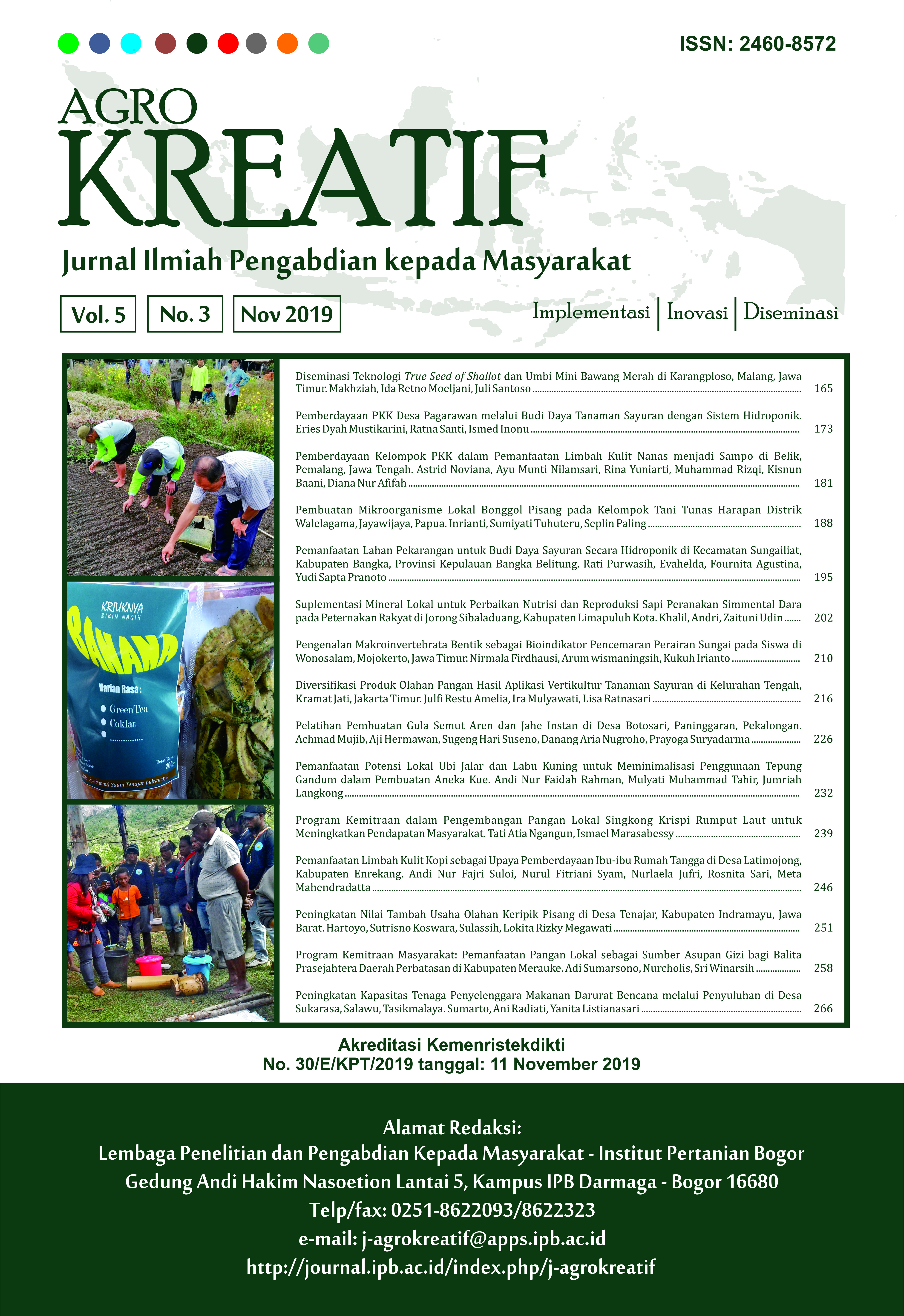Pengenalan Makroinvertebrata Bentik sebagai Bioindikator Pencemaran Perairan Sungai pada Siswa di Wonosalam, Mojokerto, Jawa Timur
Abstract
The river in Wonosalam is upstream of the rivers that flow in the Mojokerto and Jombang regions. As an upstream area, monitoring water quality of the river is needed so that pollution can be detected early. Water quality monitoring activities can be carried out using benthic macroinvertebrates indicator. The purpose of this PKM activity was to introduce water quality monitoring methods used benthic macroinvertebrates as bioindicators for students in the Wonosalam sub-district area. The main target of this activity is students of SLTPN 1 Wonosalam. The method used was lecturing, direct practicing, and discussion. Introduction of the benthic macroinvertebrates as a bioindicator was carried out very well: the students were very enthusiastic in the implementation activities from beginning to end, the students were quite active in the sampling process until the identification process, there was an increase in the students knowledge about bioindicators and the students were able to distinguish groups, EPT (Ephemeroptera, Plecoptera, and Trichoptera) and non-EPT. Based on benthic macroinvertebrate sampling the result showed that the value of the Sumber Bengawan river are 6.25, indicated that Sumber Bengawan river was not polluted.
Downloads
References
Cobo RJ, Everaert G, Iñiguez-Vela X, Córdova-Vela G, Díaz-Granda C, Cisneros F, Nopens I, Goethals PLM. 2017. A Methodology to Model Environmental Preferences of EPT Taxa in the Machangara River Basin (Ecuador). Water. 195(9): 1–31. https://doi.org/ 10.3390/w9030195
Chang CHW, Tan LYY, Goh BPL. 2013. Development of a Toxicity Bioassay Using Fertilisation in the Green Mussel, Perna viridis, from Exposure to Copper and Cadmium Environment. Asian Youth Journal Of Biology. 2013(1): 1–12.
Ecoton. 2013. Panduan Biotilik Untuk Pemantauan Kesehatan Daerah Aliran Sungai. Gresik (ID): Ecoton.
Eggen P, Donk K. 2012. Strategi dan Model Pembelajaran. Terjemahan oleh: Satrio Wahono. Jakarta (ID): PT Indeks.
Jain A, Singh BN, Singh SP, Singh HB, Singh S. 2010. Exploring Biodiversity as Bioindicators for Water Pollution. In: National Conference on Biodiversity, Development and Poverty Alleviation. On 22nd May 2010.
Li L, Zheng B, Liu L. 2010. Biomonitoring and Bioindicators Used for River Ecosystems: Definitions, Approaches and Trends. Procedia Environmental Sciences. 2: 1510–1524. https://doi.org/10.1016/j.proenv.2010.10.164
Liang LN, Hu JT, Chen DY, Zhou QF, He B, Jiang GB. 2004. Primary Investigation of Heavy Metal Contamination Status in Molluscs Collected from Chinese Coastal Sites. Bulletin of Environmental Contamination and Toxicology. 72(5): 937–944.
Parmar TK, Rawtani D, Agrawal YK. 2016. Bioindicators: The Natural Indicator of Environmental Pollution. Frontiers in Life Science. 9(2): 110–118. https://doi.org/ 10.1080/21553769.2016.1162753
Rahayu S, Widodo RH, van Noordwijk M, Suryadi I, Verbist B. 2009. Monitoring Air di Daerah Aliran Sungai. Bogor (ID): World Agroforestry Centre.
Mekong River Commission. 2010. Biomonitoring Methods for the Lower Mekong Basin. Vientiane (LA): Mekong River Commission.
World Resources Institute. 2001. Part 2: Taking stock of ecosystem. In: World Resources Institute (Ed) World Resources 2000-2001. Washington, DC (US): Elsevier. pp. 43–145. https://doi.org/10.1016/B978-008043781-1.50002-5.
This work is licensed under a Creative Commons Attribution-NonCommercial 4.0 International License.



















